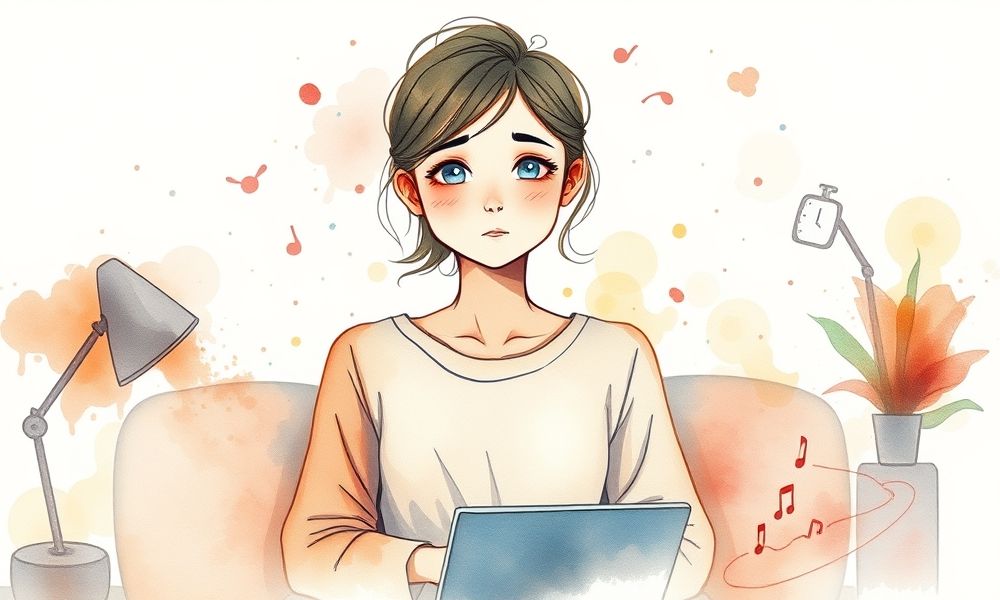Working from home can mess with your head in ways you didn’t see coming. One day you’re celebrating the death of your commute, and the next you’re having a full conversation with your houseplant because it’s been three days since you talked to another human being.
You know what I mean? That weird space where your bedroom becomes your boardroom, and suddenly you can’t tell if it’s Tuesday or Saturday because every day blends into this strange work-life soup. I mean, who among us hasn’t attended a Zoom meeting in pajama pants while questioning our life choices?
Here’s the thing about mental health working from home – it’s not just about missing office gossip or free coffee. We’re talking about real psychological shifts that can leave you feeling isolated, anxious, or completely burned out. But the good news? There are actually some pretty solid ways to keep your brain happy while you work in your personal space.
The Real Talk About Remote Work Mental Health
Working from home sounds like a dream until you realize your kitchen table has become mission control and your cat is your only coworker. The stats are kind of wild – studies show that remote workers are actually more likely to experience anxiety and depression symptoms compared to their office-bound counterparts.
I was reading this research from the Integrated Benefits Institute, and get this: 40% of fully remote workers report anxiety and depression symptoms versus 35% of in-person workers. Not a massive gap, but significant enough to make you think.
The weirdest part? You’d expect working from home to be less stressful. No commute, no office politics, wear whatever you want – what’s not to love? But our brains are funny things. We’re social creatures who thrive on routine and connection, and working from home can accidentally strip away both of those things.
Actually, scratch that – let me be more honest. Sometimes it’s not accidental at all. Sometimes we get so caught up in the flexibility that we forget to create structure. Or we get so comfortable that we stop making an effort to connect with people. Before you know it, you’re three weeks into eating lunch at your desk every day and wondering why you feel weird.
When Home Becomes Your Everything (And Why That’s Tricky)
This is where things get interesting. Your home used to be your sanctuary – the place you escaped to after work. Now it’s your office, your break room, your conference center, and still somehow supposed to be your relaxation zone. Talk about mixed signals for your brain.
I’ve noticed something with people who work from home long-term. They start developing these strange relationships with their spaces. One friend told me she can’t sit on her couch anymore without feeling guilty because her brain associates every piece of furniture with work. Another guy I know has to physically leave his apartment to feel “off work” – even just sitting on the front steps helps.
The boundary thing is real, and it affects your mental state more than you might think. When everything happens in the same four walls, your brain struggles to shift gears. It’s like trying to sleep in a place where you also exercise – your mind doesn’t know what mode it’s supposed to be in.
Plus, there’s this subtle pressure that comes with working from home. Since you’re “comfortable” and have “flexibility,” there’s this underlying expectation that you should be more productive, more available, more grateful. But sometimes comfort can become its own kind of trap.
The Isolation Factor Nobody Wants to Talk About
Can we be honest about something? Working from home can be lonely as hell. Not just “I miss chatting with Sarah from accounting” lonely, but genuinely isolating in a way that creeps up on you.
Office small talk might seem trivial, but it serves a real psychological purpose. Those random conversations about weekend plans or complaints about the printer – they’re social glue. They remind you that you’re part of something bigger than your laptop screen.
When you work from home, you lose those micro-connections throughout the day. Sure, you might have video calls, but there’s something different about scheduled interactions versus organic social moments. Video fatigue is real too – after a while, looking at people through screens starts feeling more exhausting than energizing.
I read somewhere that loneliness affects our physical health similarly to smoking 15 cigarettes a day. That might sound dramatic, but isolation really can mess with your immune system, sleep patterns, and overall well-being. Your brain starts treating social isolation as a threat, which keeps your stress hormones elevated.
The tricky part is that remote work isolation doesn’t always feel obvious. You might be busy, productive, even content most of the time. But then you have those moments – maybe when you’re making dinner or lying in bed – where this wave of disconnection hits you. It’s subtle but persistent.
Why Your Brain Craves Routine (Even If You Think You Don’t)
Here’s something I found fascinating: our brains are basically prediction machines. They’re constantly trying to figure out what’s coming next so they can prepare the right responses. Routines help with this – they give your brain a roadmap for the day.
When you worked in an office, you had built-in structure. Wake up, shower, commute, coffee, meetings, lunch break, more work, commute home. Your brain knew the rhythm. Working from home can throw all of that out the window, and sometimes our minds don’t handle the sudden freedom as well as we’d expect.
Without external structure, some people thrive and create their own systems. Others flounder a bit, ending up in this weird limbo where work bleeds into personal time and nothing feels quite finished or separate. Your brain starts sending mixed signals about when to be “on” and when to relax.
I’ve talked to remote workers who say the hardest part isn’t the work itself – it’s the mental gymnastics of constantly deciding what to do next. Should I take a break now? Is this a good time for lunch? Can I stop working at 4 PM today or should I keep going? All those tiny decisions add up to something called decision fatigue, and it’s surprisingly draining.
The lack of routine can also mess with your sleep patterns and energy levels. Your body doesn’t know when to gear up for productivity and when to wind down for rest. It’s like living in perpetual jetlag, but without the fun vacation part.
Strategy #1: Create Sacred Spaces (Even in a Studio Apartment)
Alright, let’s get practical. The first game-changer for mental health working from home is creating dedicated spaces, even if you’re working with limited square footage. I know, I know – easier said than done when you’re living in a place where your bed doubles as your desk chair.
But here’s the thing: your brain needs visual and physical cues to shift between work mode and life mode. It doesn’t have to be a separate room – it can be as simple as a specific corner of your living room or even just a particular chair that becomes your “office.”
One remote worker I know lives in a tiny studio, but she’s got this whole ritual. Every morning, she moves a small plant from her nightstand to her desk. At the end of the day, the plant goes back to the nightstand. Sounds silly? Maybe. But it works for her brain.
The key is consistency and intentionality. Maybe it’s using a specific mug for work coffee versus weekend coffee. Or putting on “work clothes” (even if they’re just different sweatpants) to signal the start of your workday. Your brain loves these little ceremonies – they help create mental boundaries when physical ones aren’t possible.
If you can swing it, invest in some basic ergonomic setup. Not just for your back and wrists, but for your mental state. There’s something about having a proper workspace that makes you feel more professional and focused. It doesn’t have to be expensive – even a laptop stand and a separate keyboard can make a huge difference in how you feel about your work environment.
And here’s a weird tip that actually works: try to position your workspace so you’re not facing a wall if possible. Looking out a window or at least toward an open room can help prevent that claustrophobic feeling that sometimes comes with working from home. Your eyes need places to rest, and your mind needs the sense of openness.
Strategy #2: Master the Art of Micro-Connections
Since we can’t rely on office interactions anymore, we need to get creative about staying connected to other humans. But I’m not talking about scheduling more video calls – those can actually make isolation worse if they feel forced or performative.
Think smaller and more organic. Send random texts to colleagues about non-work stuff. Share funny articles or memes. Jump on voice calls instead of typing out long email chains. The goal is to recreate those spontaneous moments of human connection that happen naturally in shared spaces.
One thing that works surprisingly well is body doubling – basically working “alongside” someone virtually. You don’t have to talk or even work on related projects. Just being on a video call with someone else who’s also working can reduce that isolated feeling. It’s like having a study buddy, but for grown-up work.
Consider joining online communities for remote workers or people in your industry. Not networking events or professional development stuff – just casual spaces where people hang out and chat. The key is finding your people, even if they’re scattered across different time zones.
Don’t underestimate the power of local connections either. Maybe work from a coffee shop once a week, or co-work with a friend who also works remotely. Even just being around other people can help, even if you’re not directly interacting with them.
And this might sound obvious, but… pick up the phone more often. Actually call people instead of texting. There’s something about hearing someone’s voice that feels more connecting than reading their words on a screen.
Strategy #3: Build Bulletproof Boundaries (Without Being Weird About It)
Boundary-setting when you work from home is both crucial and incredibly difficult. The problem is that traditional advice often doesn’t work in practice. “Just close the laptop” sounds great until you remember that big project deadline or that email you meant to send.
Instead of trying to create perfect separation between work and life, aim for intentional transitions. Maybe it’s taking a five-minute walk around the block after work, even if you’re not going anywhere. Or changing clothes, even if your “work outfit” and “home outfit” are basically the same thing. These little rituals help your brain shift gears.
Time boundaries are huge, but they need to be realistic. If you’re someone who naturally does better work at odd hours, don’t force yourself into a 9-to-5 schedule just because that’s “normal.” But do set some limits – maybe no work emails after 8 PM, or no working on Sundays, whatever feels manageable for your situation.
Physical boundaries matter too, even tiny ones. Close your laptop. Put it in a drawer if you have to. Clear your work papers off the kitchen table. These small actions signal to your brain that work time is over, which helps you actually relax during your downtime.
The tricky part is that some days you’ll want to blur the boundaries – maybe you want to work late because you’re in a good flow, or start early because you woke up motivated. That’s fine occasionally, but try to make it the exception rather than the rule. Your mental health needs some predictability.
Communication boundaries are important too. You don’t have to respond to every message immediately just because you’re home. Set expectations with your team about response times, and then stick to them. People will respect clear boundaries more than wishy-washy availability.

Strategy #4: Get Your Body Moving (In Non-Annoying Ways)
Exercise for mental health isn’t about becoming a fitness influencer or training for a marathon. It’s about moving your body enough to help your brain process stress and stay balanced. When you work from home, it’s easy to become surprisingly sedentary without realizing it.
The commute actually served a purpose – it was built-in movement and transition time. Now you might go from bed to desk chair to couch without taking more than 50 steps all day. Your body needs movement to function properly, and your mental state suffers when you’re too static.
But formal workouts aren’t the only answer. Maybe it’s dancing to three songs while you make lunch. Or doing some stretches during long video calls (camera off, obviously). Taking calls while walking around your apartment. The goal is just to get your blood moving and give your brain a break from stationary focus.
Fresh air makes a difference too, even if it’s just opening a window or stepping onto a balcony. There’s something about outdoor air that helps reset your mental state. If you can manage short walks outside, even better – natural light helps regulate your sleep patterns and mood.
The key is finding movement that doesn’t feel like punishment or another item on your to-do list. Maybe it’s walking to get coffee instead of making it at home. Or doing household chores with music on. Or playing with a pet. Movement doesn’t have to be structured exercise to benefit your mental health.
One thing I’ve noticed with successful remote workers is that they build movement into their workday rather than trying to fit it in before or after. Stretching between meetings, walking phone calls, standing desk setups – integrating movement into work rather than treating it as separate.
Strategy #5: Embrace Strategic Social Exposure
This one might sound counterintuitive, but sometimes you need to deliberately put yourself around other people, even if you don’t interact with them directly. It’s about combating the social isolation that can happen when you work from home.
Working from coffee shops occasionally isn’t just trendy – it actually serves a psychological purpose. Being around the ambient noise and energy of other people can boost creativity and prevent the weird cabin fever that comes from spending too much time in your own space. You don’t have to talk to anyone, but just being part of a shared environment can help.
Libraries, co-working spaces, even just working from a different room in your house can provide mental variety. The goal is to prevent your world from becoming too small and insular. Sometimes you need reminders that life is happening beyond your home office.
Video calls with friends who aren’t work-related become more important when you work remotely. Not because you need to schedule social time, but because those connections help maintain your sense of perspective and identity outside of work. It’s easy to become overly focused on work when it’s happening in the same space where you live.
Consider joining activities or groups that meet regularly, even if they’re not directly related to your interests. Book clubs, fitness classes, volunteer opportunities – anything that puts you in regular contact with people and gives you something to think about besides work.
The balance here is important though. You don’t want to over-schedule yourself or force social interactions that feel draining. The goal is quality connection, not quantity. A few meaningful interactions often work better than lots of surface-level socializing.
The Weird Psychology of Working Where You Live
There’s this fascinating thing that happens when your home becomes your office – your relationship with both spaces changes in unexpected ways. Some people start feeling like they never really leave work, while others feel like they’re never quite working hard enough. Both experiences can mess with your mental health.
Your brain creates associations with different environments, and when those environments overlap, it can create low-level confusion. You might find yourself checking work emails during weekend breakfast or feeling guilty for relaxing in the same space where you work. These mixed signals can create chronic stress without you even realizing it.
Some remote workers develop what psychologists call “spatial anxiety” – feeling unsettled in their own homes because the space no longer feels clearly defined. Others experience the opposite – becoming so comfortable that they resist leaving home for any reason, which can lead to a different kind of isolation.
The solution isn’t necessarily having a dedicated office (though that helps if it’s possible). It’s more about creating clear mental and physical transitions between work mode and life mode, even in the same space. This might mean changing lighting, music, or even just sitting in different positions for work versus relaxation.
Understanding this psychology can help you be more intentional about how you use your space and how you transition between different parts of your day. Your home environment affects your mental state more than you might realize, especially when you’re spending most of your time there.
Quick Mental Health Reality Checks
Sometimes when you’re deep in the work-from-home routine, you lose perspective on your own mental state. Here are some quick questions to ask yourself regularly:
How many days has it been since you had a real conversation with someone who isn’t on your work team? If the answer is more than a few days, it might be time to reach out to friends or family.
Are you eating meals at your desk more often than not? This is often a sign that boundaries are getting blurry and you’re not taking proper breaks.
When was the last time you left your house for something other than essential errands? Even short trips for coffee or walks in different neighborhoods can help prevent that closed-in feeling.
Do you find yourself working longer hours than you did in the office, but feeling less productive? This might indicate that you need better structure or clearer stopping points for your workday.
Are you sleeping worse since you started working from home? Sleep issues often reflect stress or boundary problems that need addressing.
How’s your physical comfort level? Working from home can lead to makeshift setups that create physical discomfort, which affects mental well-being more than people realize.
These aren’t meant to be judgmental questions – they’re just way to check in with yourself and notice patterns that might be affecting your mental health without your conscious awareness.
When Working From Home Isn’t Working
Let’s be real about something: remote work isn’t a good fit for everyone, and that’s okay. Some people genuinely thrive on the energy and structure of shared workspaces. Others need the accountability that comes from working around colleagues. There’s nothing wrong with you if working from home feels challenging.
If you’ve tried multiple strategies and still find that working from home negatively affects your mental health, it’s worth having honest conversations with your employer about hybrid options or alternative arrangements. Many companies are more flexible than they initially appear, especially if you frame it in terms of productivity and well-being.
Sometimes the issue isn’t the remote work itself, but other factors in your life that make working from home particularly challenging. Living alone, dealing with family responsibilities, or managing existing mental health conditions can all make remote work more difficult. Recognizing these factors can help you address them directly rather than assuming you’re just bad at working from home.
Professional support can be incredibly helpful if you’re struggling with the mental health aspects of remote work. Many therapists now specialize in work-related stress and can help you develop strategies specific to your situation. Employee assistance programs through work often provide free counseling sessions.
The goal isn’t to force yourself to love working from home if it’s not a good fit. It’s to make informed decisions about what work environment supports your mental health and overall well-being.
Building Your Personal Remote Work Mental Health Plan
Every person’s mental health needs are different, so cookie-cutter advice only goes so far. The key is paying attention to your own patterns and creating a personalized approach that actually works for your life and personality.
Start by noticing what specifically challenges you about working from home. Is it loneliness? Lack of structure? Difficulty focusing? Boundary issues? Identifying your particular struggles helps you target solutions more effectively.
Experiment with different strategies and give them enough time to work – sometimes it takes a few weeks to establish new habits or routines. But also don’t stick with approaches that clearly aren’t helping just because they work for other people.
Build flexibility into your plan. Your needs might change with seasons, workload, life circumstances, or just your evolving preferences. What works in winter might not work in summer. What helps during busy periods might be different from what you need during slower times.
Consider your living situation, work requirements, and personal preferences when choosing strategies. A parent working from home with young children needs different approaches than someone living alone. Someone in a studio apartment faces different challenges than someone with a dedicated office space.
Remember that maintaining good mental health while working from home is an ongoing process, not a problem you solve once and forget about. Regular check-ins with yourself and adjustments to your approach are part of making remote work sustainable long-term.
Frequently Asked Questions About Mental Health Working from Home
How do I stop feeling lonely when working from home all day? The loneliness thing is super common and honestly kind of sneaks up on you. Try scheduling regular coffee chats with colleagues, even if they’re just 15-minute video calls about random stuff. Working from coffee shops once a week helps too – you get that ambient social energy without having to actually talk to strangers. Some people find that having the TV on low in the background makes them feel less alone, or keeping a video call open with a friend who’s also working.
Is it normal to feel more anxious working from home than I did in the office? Totally normal, and you’re not going crazy. Working from home anxiety often comes from the lack of structure and social cues we used to rely on. Your brain doesn’t get those little confirmations throughout the day that you’re doing okay – like seeing your boss seem relaxed or chatting with coworkers. Try creating small routines that mimic office life, like getting dressed for work or taking a “commute” walk around the block before starting your day.
Why can’t I focus at home when I was fine at the office? Home has way more distractions than we realize, plus your brain associates home with relaxation, not work mode. The key is creating environmental cues that signal work time – maybe it’s specific music, lighting, or even just sitting in a particular chair. Also, don’t beat yourself up if your focus isn’t perfect right away. It takes time to retrain your brain for a new work environment.
How do I deal with my family not understanding that I’m actually working? This is probably the most frustrating part of working from home for a lot of people. Set clear boundaries by creating physical signals when you’re in work mode – maybe a sign on your door or wearing headphones. Have direct conversations about your work schedule and what interruptions are okay versus not okay. Sometimes people need to hear specific examples like “when you ask me to do laundry during my work hours, it’s like interrupting me in a meeting.”
What should I do if working from home is making my depression worse? First off, you’re not alone in this – studies show remote workers do have higher rates of depression symptoms. If you’re noticing your mood getting worse, don’t try to tough it out. Reach out to a therapist who understands remote work challenges, make sure you’re getting outside daily, and consider whether a hybrid work arrangement might be better for you. Some people genuinely need the structure and social interaction of an office environment.
How can I stop working from home from affecting my sleep? The bedroom-as-office thing really messes with sleep patterns because your brain can’t separate work stress from rest time. Try to work anywhere except your bedroom if possible. Create an end-of-work ritual like closing your laptop and putting it away, changing clothes, or taking a short walk. Avoid checking work emails at least an hour before bed, and consider using blue light filters on your devices in the evening.
Is it okay to take mental health days when working from home? Absolutely, and actually you might need them more than office workers because the boundaries are so blurry. Just because you’re home doesn’t mean you’re automatically relaxed or that work stress isn’t real. Mental health days when working remotely might look different – maybe it’s working from a different location, taking the afternoon off to go outside, or just having a day where you do the bare minimum and focus on recharging.



